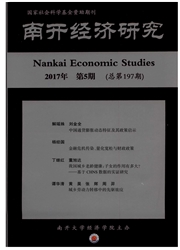

 中文摘要:
中文摘要:
本文选用超越对数函数的随机前沿模型,对1990--2006年的分省数据进行实证分析,以估算我国各地区的生产效率,并分解其全要素生产率增长率,实证结果表明:第一,东部地区生产效率最高,西部地区最低,1996--2000年各地区平均生产效率均出现了不同程度的下降,2003年之后生产效率出现上升趋势,且东部地区的增长幅度较大;第二,城市化率、各地区GDP中第二产业的比重、基础设施水平、人力资源水平和对外经济依存度对地区生产效率具有正面影响,而固定资产投资占国有经济投资比重以及政府对经济的干预程度与地区生产效率呈负相关关系;第三,就生产的不确定性而言,除人力资源水平能减少生产的不确定性之外,经济对外依存度、技术创新水平、基础设施水平、政府干预倾向都会增加生产的不确定性;第四,全要素生产率增长率在1992年之后出现了明显下降趋势,2000年之后,各地区全要素生产率增长均有显著的上升。全要素生产率的增长主要是由生产效率变化率决定,其次是技术进步率。
 英文摘要:
英文摘要:
Empirical study is conducted to test China's provincial datasets (1990--2006), using a translog production frontier specification,this paper measures technical efficiency between regions and decomposes the growth rate of TFE the findings of this study show: The east region is the most efficient while the western region is the least efficient the average technical efficiency of all regions declined form 1996 to 2000,but technical efficiency has been a gradual increase since 2003 and east region has a bigger growth; Urbanization rate, the proportion of secondary industry in GDP, infrasturcture, human resources, foreign economic dependence are important factors for efficiency improvement, but the proportion of the state-owned economy in fixed assets and government intervention are harmful to efficiency; Human resources may decrease production uncertainty,all other factors may increase uncertainty; Growth rate of TFP has declined since 1992,but has a significant growth after the year 2000. Technical efficiency is the main driving force for TFP,and technological progress is in the next place.
 同期刊论文项目
同期刊论文项目
 同项目期刊论文
同项目期刊论文
 期刊信息
期刊信息
